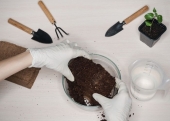


Collection of 14 Permaculture/Homesteading Cheat-Sheets, Worksheets, and Guides
will be released to subscribers in:
soon!








 1
1




I have some questions:
1) Do you think this method really works?
2) If it might, can someone be able to explain to me what goes on during the whole composting process?
3) Can I adapt this technique for composting my bagasse waste?
I like the sound of this method as you leave it in a rectangular heap for a month or two without turning, at least not till the very end, and it turns to compost.
List of Bryant RedHawk's Epic Soil Series Threads We love visitors, that's why we live in a secluded cabin deep in the woods. "Buzzard's Roost (Asnikiye Heca) Farm." Promoting permaculture to save our planet.
 2
2

























James Lam wrote:Thanks for the great replies. There are few concerns about this technique I hope you can help me address:
1) I understand why there are alternating layers of urea, in order to provide the pile a suitable C:N ratio to aid decomposition. However, at the layers where urea is situated, temperatures there will be high too I suppose. It could possibly reach 60 degree celcius when thermophillic stage takes over. Now, wouldn't this high temp kill off all the fungi spores at the layers close below, of if not, will retard their growth, as I understand the species of white rot fungi are usually a mesophillic species, although I'm not too sure about this?
2) By scattering the fungi spawn onto the waste material in alternating layers without sterilizing the coir waste, wouldn't this lead to high possibility of contamination of the spores, disabling its growth? As I know people who grow mushrooms, their first steps are always to sterilize the substrate. (sterilizing my substrate is not an option however, simply as there too much volume of it)
I made a small experimental compost pile, and added the spawn halfway through the composting process (not at the start, as illustrated in the indian coir composting method highlighted above). When I open up the pile a week later, I didn't really see much hyphae growth throughout. However, there might be few possibilities why things went wrong, i.e. I put the spawn only later during the composting process, or the spawn might not be a good quality spawn, or I keep turning the pile to check for growth every week or so, spores might be competing with composting bacteria, nitrogen might be depleted already, etc
I would like to try to make another experimental pile, but I would like some feedback from members of this forum before I try it again.
List of Bryant RedHawk's Epic Soil Series Threads We love visitors, that's why we live in a secluded cabin deep in the woods. "Buzzard's Roost (Asnikiye Heca) Farm." Promoting permaculture to save our planet.




















List of Bryant RedHawk's Epic Soil Series Threads We love visitors, that's why we live in a secluded cabin deep in the woods. "Buzzard's Roost (Asnikiye Heca) Farm." Promoting permaculture to save our planet.
















 1
1




List of Bryant RedHawk's Epic Soil Series Threads We love visitors, that's why we live in a secluded cabin deep in the woods. "Buzzard's Roost (Asnikiye Heca) Farm." Promoting permaculture to save our planet.





